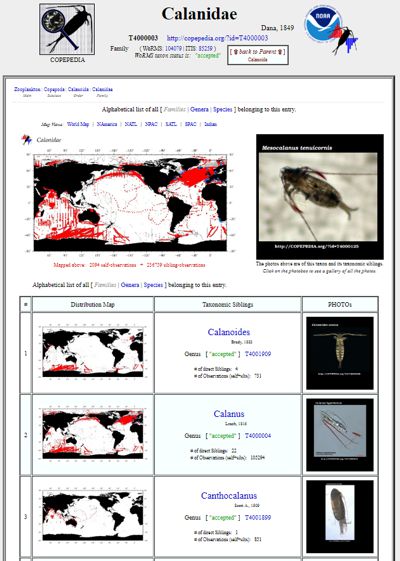COPEPEDIA is an in-development database of plankton taxa distribution maps, photographs, biometric traits, and genetic markers cooperatively compiled by ICES WGIMT, WGZE, WGPME, and the NOAA Fisheries COPEPOD project.
COPEPEDIA serves as the taxonomic management system for the COPEPOD project, synchronizing its databases, time series, and taxa-based international collaboration activities, all through a unique taxonomic identifier called a "taxonomic copePID" (or "copePID" for short).
This eight-character copePID (e.g., Calanus fimarchicus = T4000005) can be used to identify the species and is used to link it to its COPEPEDIA entry (https://copepedia.org/?id=T4000005).
The COPEPEDIA entry for Calanus finmarchicus (T4000005) summarizes its taxonomic hierachical placement, authority and validity, and features a map of its geographic distribution.
In the upper right corner, a photo gallery shows community-submitted microscope-aided photographs of this species.
Below the distribution map, the biometric data table features length-weight equations for this species.
At the bottom, tables link to Time Series and COPEPOD data sets that reports this species.
COPEPEDIA uses the World Registry of Marine Species (WoRMS) to verify the taxonomic nomenclature of its contents.
|
|

The screenshot above shows the COPEPEDIA entry for the copepod family "Calanidae". The map shows observations where members of this family have been found in the samples. Below this map, links to genera of this family are listed in alphabetical order. When available, COPEPEDIA includes taxonommically-assigned photographs, biometric data (e.g., individual weights or lengths) and limited genetic primer information.
|